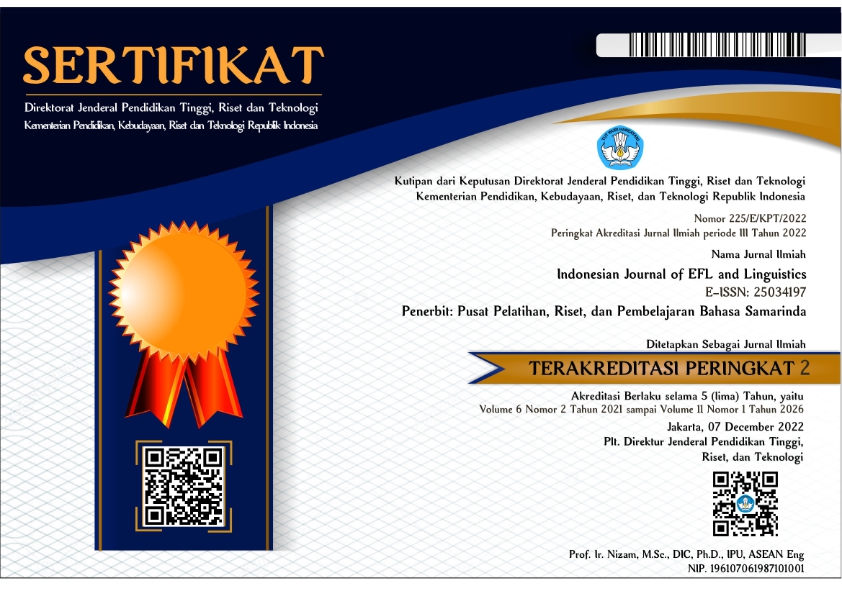Development of Picture Book Media for Expressive Language Skills of Children With Autism
Keywords:
Media, Expressive language, Autism
Abstract
The expressive language skills of children with autism can be improved through teaching and learning. One of the factors supporting the success of teaching and learning process in improving the expressive language skills of children with autism is the selection of media which is in accordance with the characteristic of children with autism as target of learning. Children with autism are known to conceive information based on visual as their characteristic, so visual-based media will be more effectively in the learning process. This study uses the ADDIE (Analyze, Design, Development, Implementation, and Evaluation) development model that aims to develop visual-based media that can accommodate the expressive language skills of children with autism. The media developed is in form book-shaped media that contains a combination of writing and image illustration. This study produces a decent picture book media based on material conformity with curriculum, grammar used, media display, and communication theory used.References
Allen, E & Cowdery, G. (2012). The Exceptional Child: Inclusion in Early Childhood Education, Seventh Edition. USA: Wadsworth Cengange Learning.
Arrum, D. (2012). http://repository.usu.ac.id (diakses pada 3 Oktober 2017).
Hallahan, D. P., Kauffman, J. M., & Pullen, P. C. (2009). Exceptional Learners: An Introduction to Special Education. USaA; Pearson.
Hayes, G. R., Hirano, S., Marcu, G,. Monibi, M., Nguyen, D. H., & Yegayan, M. (2010). Interactive Visual Supports For Children With Autism. Pers Ubiquit Comput (14). 663-680.
Indina, G., Handajani, R. P., & Laksmiwati, T. (2004). Penerapan Warna dan Cahaya Pada Interior Ruang Terapi Dasar dengan Pendekatan Visual Anak Autis.
Kurt, O. (2011). A Comparison of Discrete Trial Teaching with and without Gestures/Signs in Teaching Receptive Language Skills to Children with Autism, Educational Science: Theory & Practice, 11(3), 1436–1445.
Nurgiantoro, Burhan. (2012). Sastra Anak: Pengentar Pemahaman Dunia Anak. Yogyakarta: Gajah Mada University Press.
Pamuji. (2007). Model Terapi Terpadu bagi Anak Autis. Jakarta: Dirjen Dikti.
Pamuji. (2014). Adaptasi Media Pembelajaran Gambar untuk Meningkatkan Aktivitas Belajar Anak Autis. Jurnal Ortopedagogia, 1(2). 117-127.
Pujiati. (2007). Pengembangan Bahan Ajar Praktikum Pengantar Akuntansi. Jurnal Ekonomi dan Pendidikan, 4(2).
Sadiman, Arif S. (2011). Media Pendidikan: Pengertian, Pengembangan, dan Pemanfaatannya. Jakarta: PT. Rajagrafindo Persada.
Santoso, Hari. (2011). Membangun Minat Baca Anak Usia Dini Melalui Penyediaan Buku Bergambar. Artikel Pustakawan UM. 7-15.
Shane, H. C., Laubscer, E. H., Schlosser, R. W., Flynn, S., Sorce, J. F., Abramson, J. (2012). Applying Technology to Visually Support Language and Communication in Individuals with Autism Spectrum Disorders. Journal of Autism and Developmental Disorders, 42 (6). 1228-1235.
Sigafoos, J. (2010). Introduction to The Special Issue on Augmentative and Alternative Communication. Journal of Developmental and Physical Disabilities, 22. 101-104.
Sunarya, Agus. (2004). Terapi Autisme, Anak Berbakat, dan Anak Hiperaktif. Jakarta: Progres.
Thompson, Jenny. (2010). Memahami Anak Berkebutuhan Khusus. Jakarta: Penerbit Erlangga.
Zulela. (2013). Pembelajaran Bahasa Indonesia: Apresiasi Sastra di Sekolah. Bandung: PT. Remaja Rosda Karya.
Arrum, D. (2012). http://repository.usu.ac.id (diakses pada 3 Oktober 2017).
Hallahan, D. P., Kauffman, J. M., & Pullen, P. C. (2009). Exceptional Learners: An Introduction to Special Education. USaA; Pearson.
Hayes, G. R., Hirano, S., Marcu, G,. Monibi, M., Nguyen, D. H., & Yegayan, M. (2010). Interactive Visual Supports For Children With Autism. Pers Ubiquit Comput (14). 663-680.
Indina, G., Handajani, R. P., & Laksmiwati, T. (2004). Penerapan Warna dan Cahaya Pada Interior Ruang Terapi Dasar dengan Pendekatan Visual Anak Autis.
Kurt, O. (2011). A Comparison of Discrete Trial Teaching with and without Gestures/Signs in Teaching Receptive Language Skills to Children with Autism, Educational Science: Theory & Practice, 11(3), 1436–1445.
Nurgiantoro, Burhan. (2012). Sastra Anak: Pengentar Pemahaman Dunia Anak. Yogyakarta: Gajah Mada University Press.
Pamuji. (2007). Model Terapi Terpadu bagi Anak Autis. Jakarta: Dirjen Dikti.
Pamuji. (2014). Adaptasi Media Pembelajaran Gambar untuk Meningkatkan Aktivitas Belajar Anak Autis. Jurnal Ortopedagogia, 1(2). 117-127.
Pujiati. (2007). Pengembangan Bahan Ajar Praktikum Pengantar Akuntansi. Jurnal Ekonomi dan Pendidikan, 4(2).
Sadiman, Arif S. (2011). Media Pendidikan: Pengertian, Pengembangan, dan Pemanfaatannya. Jakarta: PT. Rajagrafindo Persada.
Santoso, Hari. (2011). Membangun Minat Baca Anak Usia Dini Melalui Penyediaan Buku Bergambar. Artikel Pustakawan UM. 7-15.
Shane, H. C., Laubscer, E. H., Schlosser, R. W., Flynn, S., Sorce, J. F., Abramson, J. (2012). Applying Technology to Visually Support Language and Communication in Individuals with Autism Spectrum Disorders. Journal of Autism and Developmental Disorders, 42 (6). 1228-1235.
Sigafoos, J. (2010). Introduction to The Special Issue on Augmentative and Alternative Communication. Journal of Developmental and Physical Disabilities, 22. 101-104.
Sunarya, Agus. (2004). Terapi Autisme, Anak Berbakat, dan Anak Hiperaktif. Jakarta: Progres.
Thompson, Jenny. (2010). Memahami Anak Berkebutuhan Khusus. Jakarta: Penerbit Erlangga.
Zulela. (2013). Pembelajaran Bahasa Indonesia: Apresiasi Sastra di Sekolah. Bandung: PT. Remaja Rosda Karya.
Published
2019-05-01
How to Cite
Suistika, R., & Ishartiwi, I. (2019). Development of Picture Book Media for Expressive Language Skills of Children With Autism. Indonesian Journal of EFL and Linguistics, 4(1), 27-39. https://doi.org/10.21462/ijefl.v4i1.94
Section
Articles




